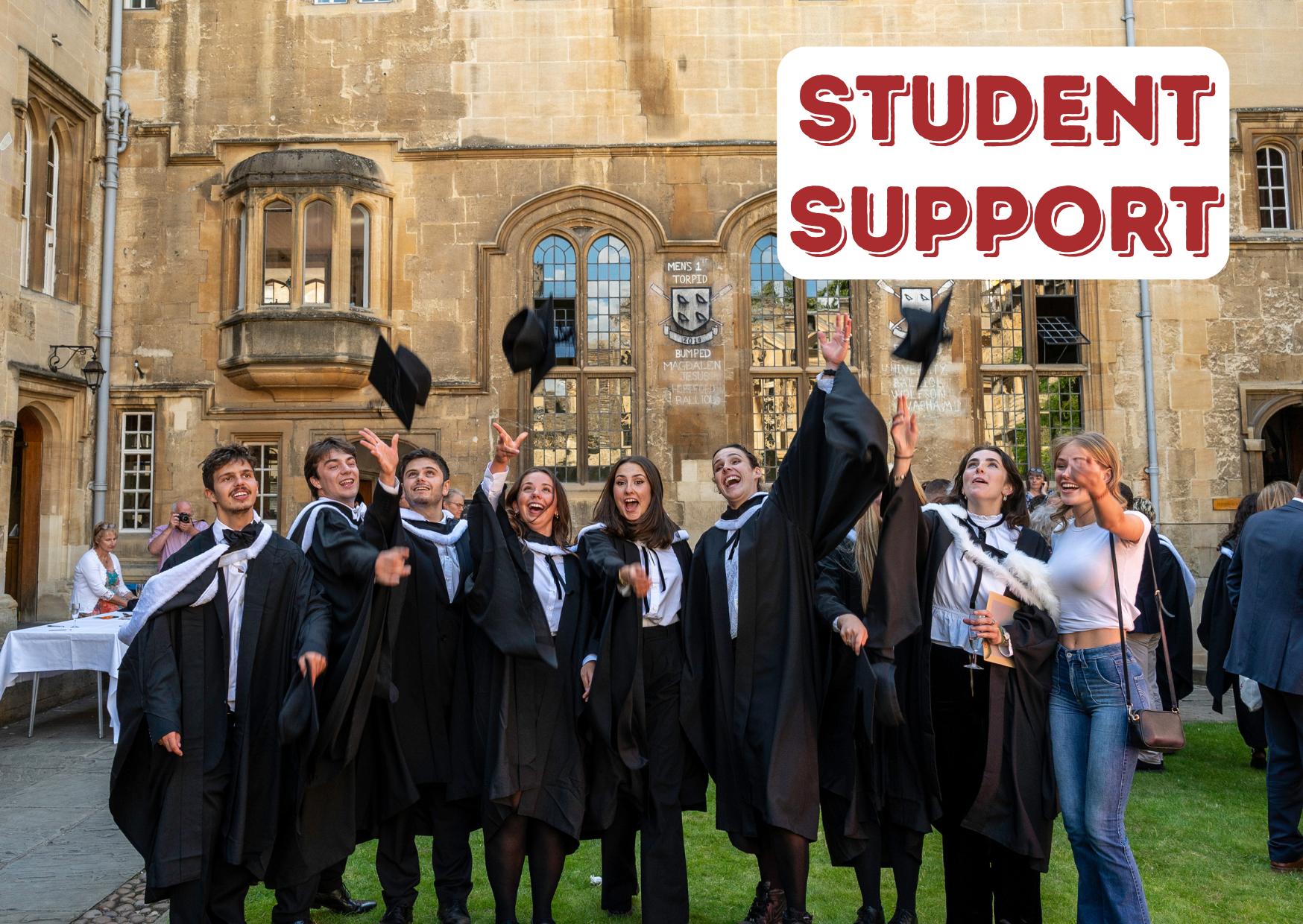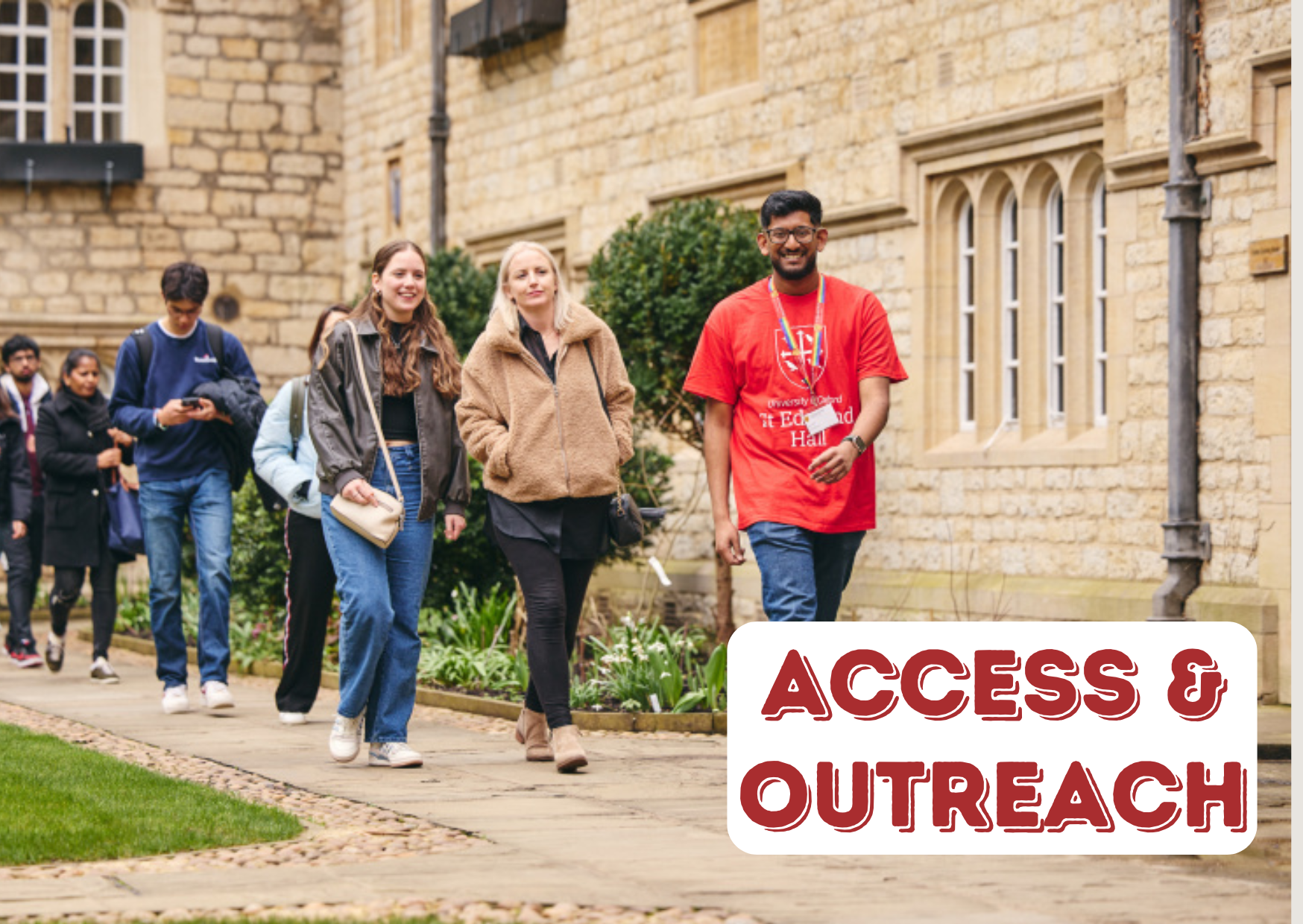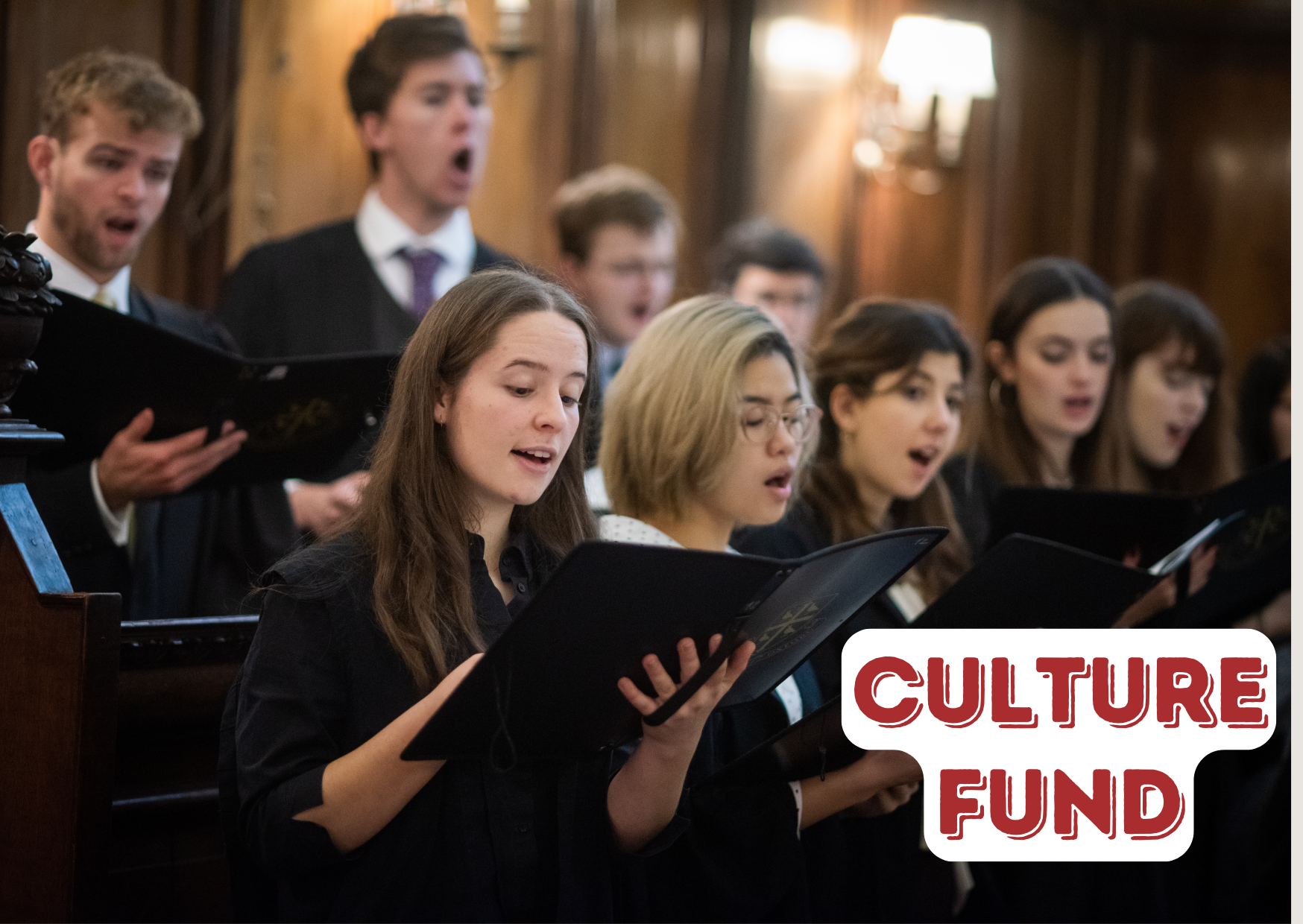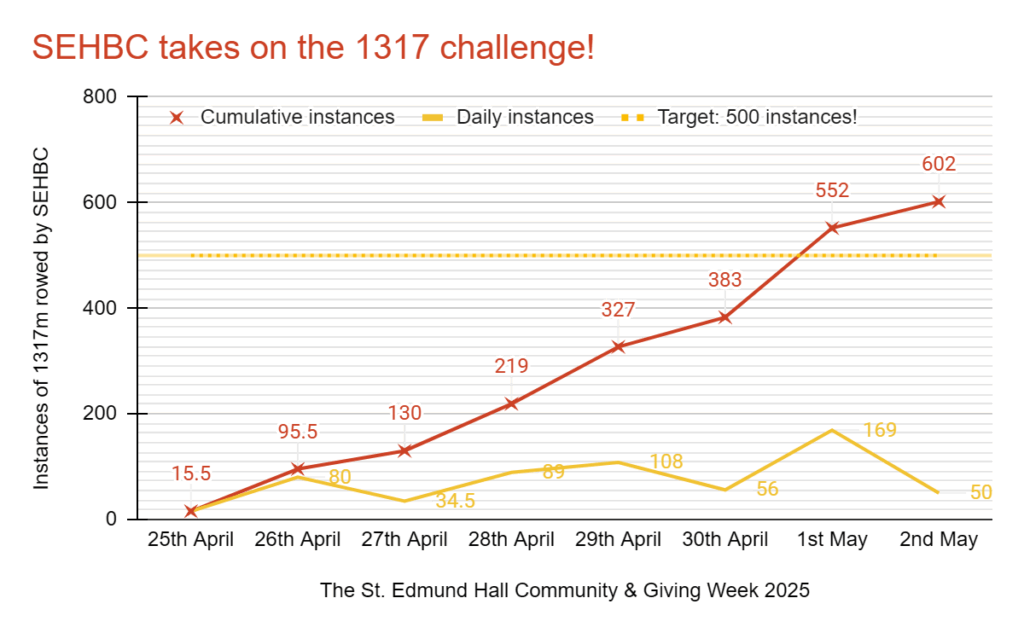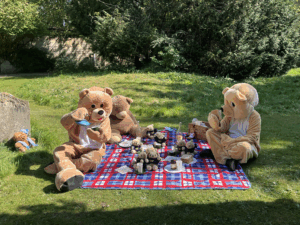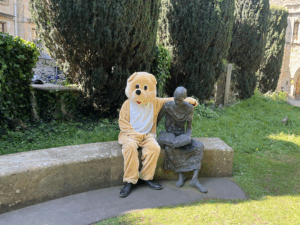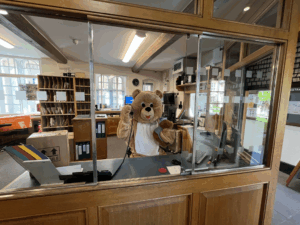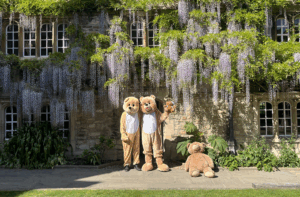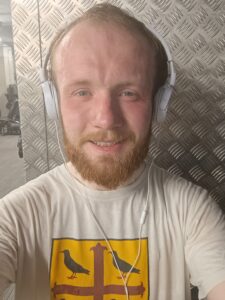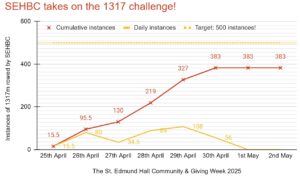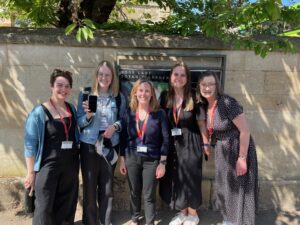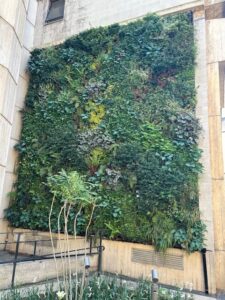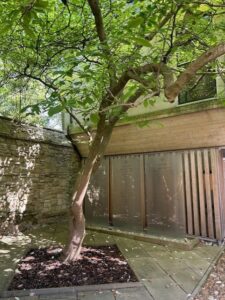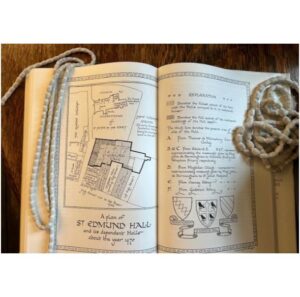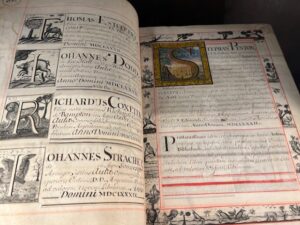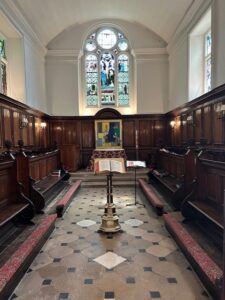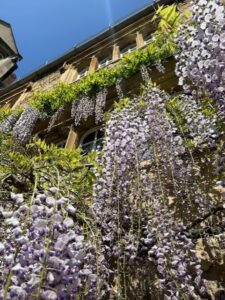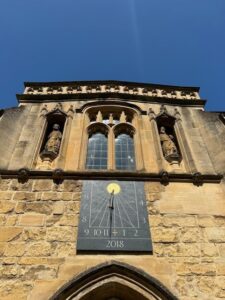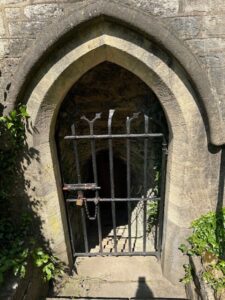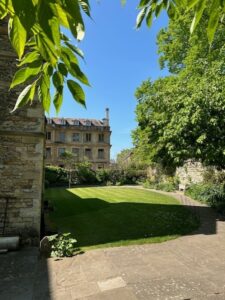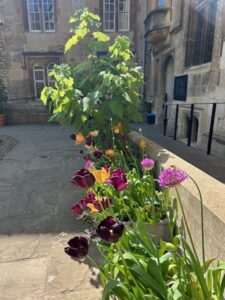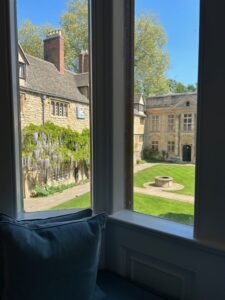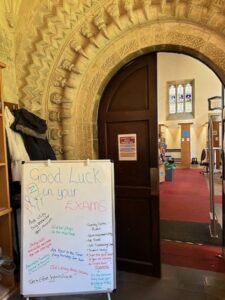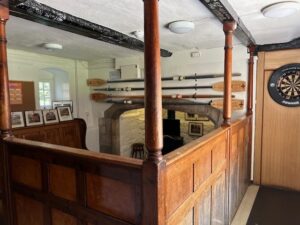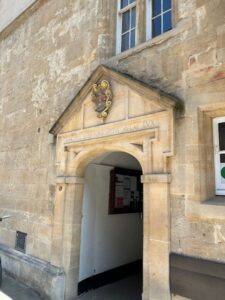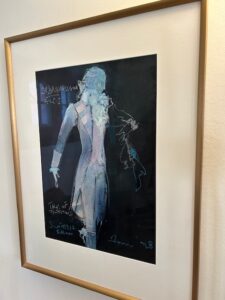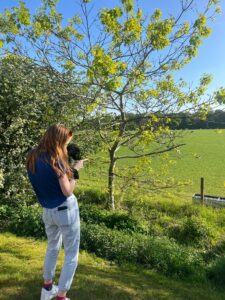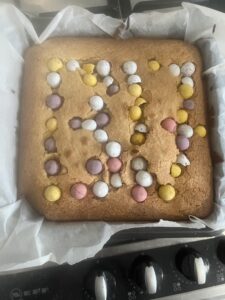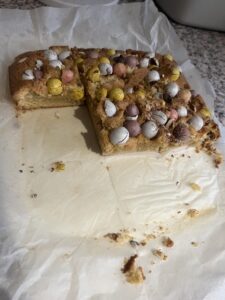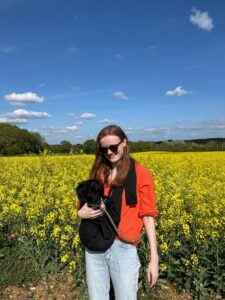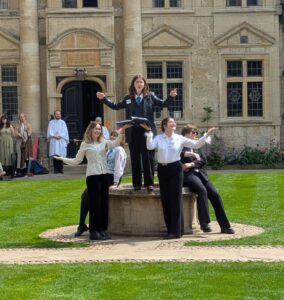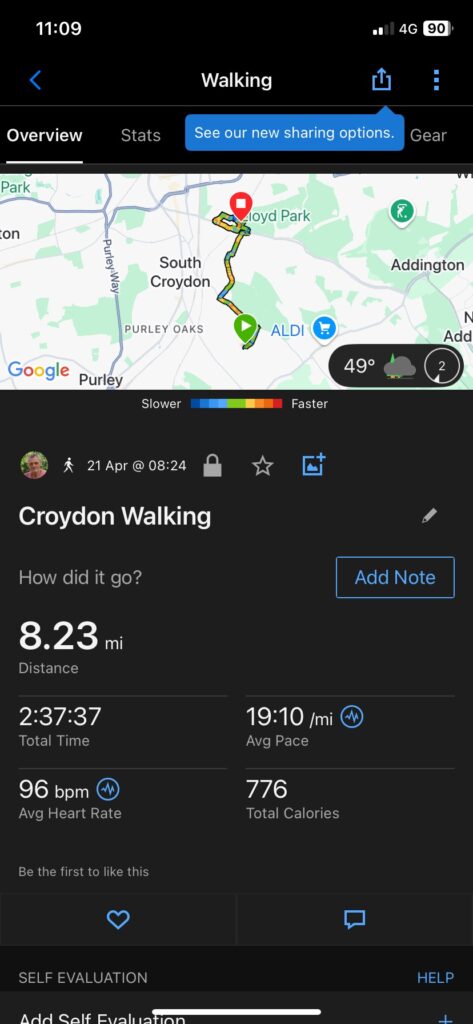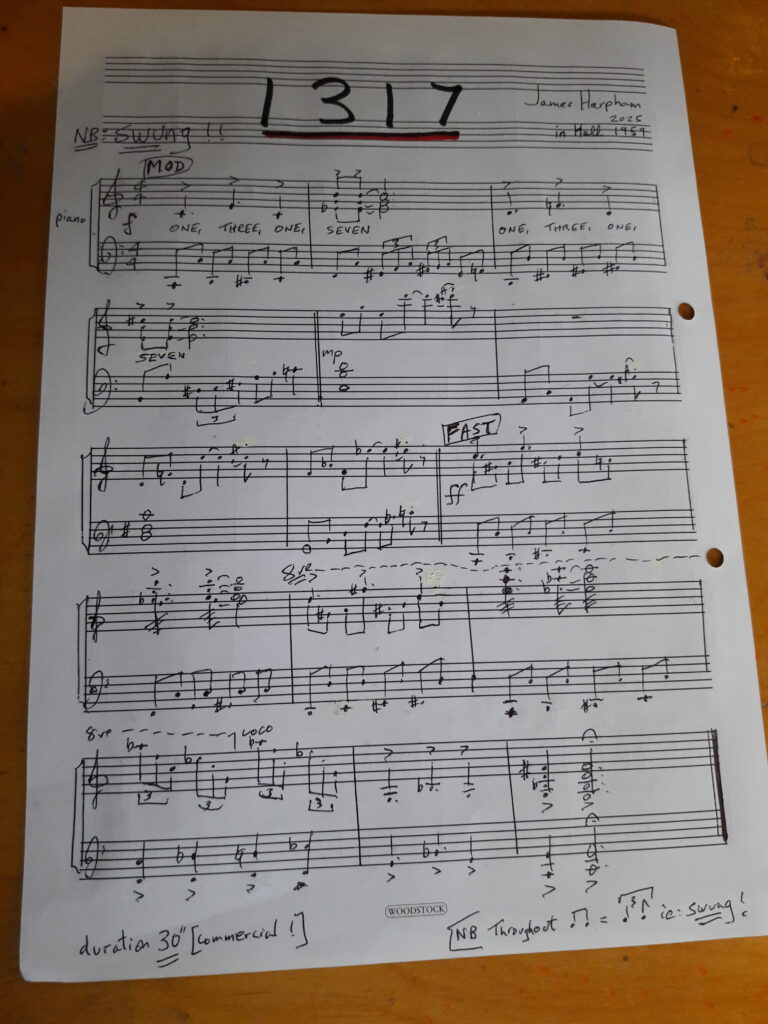
ST EDMUND HALL COMMUNITY & GIVING WEEK
25 April–2 May 2025
From Friday 25 April to Friday 2 May 2025, the inaugural Community & Giving Week took place at St Edmund Hall, bringing together students, Fellows, staff, alumni and friends in a week-long celebration of community, growth and giving.
A big, heartfelt thank you to our Aularian community for enthusiastically embracing the week, by getting involved in our 1317 Challenge and through your generous gifts to the Hall. The fundraising campaign exceeded all expectations with over £140,000 raised in total, surpassing the original goal of £131,700.
During the week and inspired by the first documented reference to St Edmund Hall in 1317, we invited members of the Teddy Hall community to take on the 1317 Challenge and complete exciting activities with a focus on the College and the number 1317. Aularians around the world responded with enthusiasm, sending in a wide range of creative and exciting challenges, including hikes, poetry, baked goods, rowing challenges, and musical and theatrical arrangements – full details of the completed challenges can be found in the table below. As part of the challenge, participants were entered into a prize draw – many congratulations to our winners:
- Current student Poppy Buckley (2021, Biomedical Sciences)
- Current student Tiffany You (2023, Philosophy, Politics and Economics)
- Alumnus James Harpham (1959, History).
Supporting Community & Giving Week
During St Edmund Hall Community & Giving Week 2025, our fundraising focused on:
- Student Support
- Access & Outreach initiatives
- Extracurricular activities like Sports, Arts & Music
Even though the week has now come to a close, you can still support these vital funds by making a gift using the buttons below:
Completed challenges
| Activity |
THANK YOU!Over 200 contributors have helped us exceed our fundraising goal of £131,700.
|
| Toby Lucas (1973, Philosophy, Politics & Economics) made a donation to the Aularian Fund. Make Your Gift Today. |
| Olivier Cédelle (2011, MBA) made a donation to the Norham St Edmund Development. Make Your Gift Today. |
| Anonymous has started a regular gift of £5 per month towards Student Welfare and Wellbeing. Make Your Gift Today. |
| Rebecca Hilton (2016, Jurisprudence) made a donation to Student Bursaries & Financial Assistance. Make Your Gift Today. |
| Michael Pike (1968, English Language & Literature) made a donation to the Aularian Fund. Make Your Gift Today. |
| Elizabeth Taylor (1999, Clinical Medicine) made a donation to Student Bursaries & Financial Assistance. Make Your Gift Today. |
| Michael Sprague (2010, Atomic and Laser Physics) made a donation to the Aularian Fund. Make Your Gift Today. |
|
Congratulations to St Edmund Hall Boat Club (SEHBC) on completing their 1317 Challenge. The club were aiming to “row over 500 instances of 1317m, either on the water, or on rowing machines” and smashed their goal, rowing 1317m 602 times across the week!
“Top three athletes with instances of 1317m rowed over the week: Massive shout out to our Treasurer, Cyril Schroeder, who ran a marathon on the 27th April, one of our Social Secretaries, Lucy Robinson, who also cycled over 100km over the week, and one of our novices, Del Rajan, who rowed 17*1317m in a single day.” |
| Brian Hepworth (1986, Computation) made a donation to the Aularian Fund. Make Your Gift Today. |
| Bartosz Redlicki (2008, Economics & Management) made a donation to the Aularian Fund. Make Your Gift Today. |
| Koo-Yong Park (1995, Engineering Science) made a donation to Student Bursaries & Financial Assistance. Make Your Gift Today. |
| Roger Miller (1962, Geography) made a donation to the Aularian Fund. Make Your Gift Today. |
| Andrew Sumnall (1983, Medicine) made a donation to the Sports Fund. Make Your Gift Today. |
| Alex Morel (2005, Geography and the Environment) made a donation to the Aularian Fund. Make Your Gift Today. |
| Michael Spilberg (1968, English Language & Literature) made a donation to the Aularian Fund. Make Your Gift Today. |
| Bill Walker (1965, History) made a donation to the Aularian Fund. Make Your Gift Today. |
| Richard Gozney (1970, Geology) made a donation to the Aularian Fund. Make Your Gift Today. |
| Andrew Vivian (Director of Development) made a donation of £13.17 towards Access and Outreach. Make Your Gift Today. |
| Christopher Pretty (1973, Modern History) made a donation to the Sports Fund. Make Your Gift Today. |
| Darrell Barnes (1963, French and German) made a donation to the Aularian Fund. Make Your Gift Today. |
|
Community & Giving Week is bringing out all sorts! You never know who’s going to greet you when you come to the Hall…
|
| David Bowen (1959, Metallurgy & Science of Mater) made a donation towards the Music, Arts and Culture Fund. Make Your Gift Today. |
| Giles Sanders (1988, Chemistry) made a donation towards Access and Outreach. Make Your Gift Today. |
| Pete Kite (1958, Physics) made a donation to the Aularian Fund. Make Your Gift Today. |
| Ioana Grigoras (2017, Neuroscience) made a donation to Student Bursaries & Financial Assistance. Make Your Gift Today. |
| Melanie Gurney (2011, Fine Art) made a donation to the Aularian Fund. Make Your Gift Today. |
| Alan Rowland (1959, Engineering Science) made a donation towards Norham St Edmund. Make Your Gift Today. |
| Timothy Powell (2017, French and German & 2024, DPhil German) “I cycled 13.17 km (8.18 miles) per day on the exercise bike at my gym in Oxford from 26 April-1 May to raise money for Student Support at Teddy Hall. I clocked up a total of 92.25 km (57.32 miles) across the week and “crossed the finish line” in my Teddy Hall freshers’ T-shirt yesterday!
|
| Ant Hawkes (1962, History) made a donation to the Aularian Fund. Make Your Gift Today. |
| Charles Blount (1977, Geography) made a donation to the Aularian Fund. Make Your Gift Today. |
| Philip Eggleston (1974, Modern Languages) made a donation to the Aularian Fund. Make Your Gift Today. |
| Rebecca Hilton (2016, Jurisprudence) made a donation to Student Bursaries & Financial Assistance. Make Your Gift Today. |
| Robert Godden (1973, Physics) made a donation to the Aularian Fund. Make Your Gift Today. |
| Robert Vollum (1979, Engineering Science) made a donation to the Aularian Fund. Make Your Gift Today. |
| Rupert Snuggs (2002, Engineering Science) made a donation to the Aularian Fund. Make Your Gift Today. |
| Tim Miles (1981, Modern Languages) made a donation to the Aularian Fund. Make Your Gift Today. |
|
Lydia Smith (Regular Giving Officer) “I recently got a new puppy, Lemon, who we cannot yet take out for walks as we wait for her to get her final vaccinations. This week, I will do the walking for her, taking my puppy in a bag for a daily walk of 1.317 miles or more and writing a daily summary using 13 or 17 words.” Day Seven in 13 words: Last walk of the week, a tiring one for a 3 month old!
|
| Amy Poole (1994, Philosophy, Politics & Economics) made a donation to the Aularian Fund. Make Your Gift Today. |
| Genevieve Holland (1994, Philosophy, Politics & Economics) & James Holland (1994, Mathematics & Philosophy) made a donation of $1,000 to the Aularian Fund. Make Your Gift Today. |
| Lucy Durrans (2009, Materials Science) made a donation to the Aularian Fund. Make Your Gift Today. |
| Anonymous made a donation to the Aularian Fund. Make Your Gift Today. |
| James Matthews (1998, Jurisprudence) made a donation to the Aularian Fund. Make Your Gift Today. |
|
SEH Boat Club have been busy this week! “From the beginning of the Community & Giving Week, SEHBC have taken the 1317 challenge in its stride, with over two dozen members putting in training logs to participate. In the first several days of the challenge, members have collectively rowed over 500km (a distance equal to driving from Oxford to Edinburgh), and we are hoping to row over 500 instances of 1317m, either on the water, or on rowing machines. Currently, the top three members are: – Sabina Sulikova, who has rowed 41*1317m; – Will Randell, who has rowed 38*1317m, and; – Ben Keates, who has rowed 26.5*1317m. We will continue on our upwards trajectory, and hope to meet our target by Friday!”
|
| John Bloomer (1984, Chemistry) made a donation to the Aularian Fund. Make Your Gift Today. |
| George Palmer (1997, Jurisprudence) made a donation to the Aularian Fund. Make Your Gift Today. |
| Cara Krmpotich (2004, Social and Cultural Anthropology) made a donation to the Aularian Fund. Make Your Gift Today. |
| Anonymous made a donation to the Aularian Fund. Make Your Gift Today. |
| Peter Rogers (1972, Metallurgy & Science of Mater) made a donation to the Aularian Fund. Make Your Gift Today. |
| Akira Mitsumasu (2000, MBA) made a donation towards Norham St Edmund. Make Your Gift Today. |
| Akira Mitsumasu (2000, MBA) made a donation to the Aularian Fund. Make Your Gift Today. |
| Anonymous made a donation to Student Bursaries & Financial Assistance. Make Your Gift Today. |
|
Luke Boulton (2022, Medicine) performed “1317” – a carefully swung boogie piano piece based on the notational sequence: 1317 – for the first time. The piece was written especially for Community and Giving Week by James Harpham (1959, History). |
| Richard Gretton (1973, Geography) has started a regular gift of £13.17 per month to the Aularian Fund. Make Your Gift Today. |
| Zoe Noonan (1999, Modern History) made a donation to the Aularian Fund. Make Your Gift Today. |
| Huijuan Wu (2009, Engineering Science) made a donation to the Aularian Fund. Make Your Gift Today. |
| Anonymous made a donation towards Access and Outreach. Make Your Gift Today. |
|
Lydia Smith (Regular Giving Officer) “I recently got a new puppy, Lemon, who we cannot yet take out for walks as we wait for her to get her final vaccinations. This week, I will do the walking for her, taking my puppy in a bag for a daily walk of 1.317 miles or more and writing a daily summary using 13 or 17 words.” Day Six in 17 words: Channeling her inner disney princess, Lemon looks up at me having found a home amongst the daisies.
|
| Andrew Wathey (1976, Music) made a donation towards the Music, Arts and Culture Fund. Make Your Gift Today. |
| Gerard Yuen (1994, Philosophy, Politics and Economics) made a donation to the Aularian Fund. Make Your Gift Today. |
| Felicia Shaw (2002, Earth Sciences) made a donation to the Aularian Fund. Make Your Gift Today. |
|
Henrike Lähnemann (Professor of Medieval German Literature and Linguistics) Hall Heralds hail May Morning in 1317-style! From the tower room of St Peter-in-the-East, a group of Teddy Hall musicians gathered to play May madrigals for 13 minutes and 17 seconds to celebrate May Day. |
|
Nigel Purse (1982, Modern History) has issued a “match-me challenge” for all Aularians to match his gift through a one off donation of £1,317 or by setting up a monthly gift of £13.17 per month. “It just struck me that there are roughly 10,000 Aularians. If every Aularian were to give £1,317, then that would raise a total of £13.17m. I know that not every Aularian will be in a position to give. But, I would like to bet that a good many can. Now, it occurs to me that I must be just about the most ordinary person ever lucky enough to have been admitted to the Hall. So, if I can do it, then so can many other Aularians.” |
|
Lydia Smith (Regular Giving Officer) “I recently got a new puppy, Lemon, who we cannot yet take out for walks as we wait for her to get her final vaccinations. This week, I will do the walking for her, taking my puppy in a bag for a daily walk of 1.317 miles or more and writing a daily summary using 13 or 17 words.” Day Five in 13 words: Finally down on the ground, on four legs – found to be absolutely exhausting.
|
| Nigel Purse (1982, Modern History) made a donation of £1,317 towards Access and Outreach. Make Your Gift Today. |
| Chris Manby (1990, Experimental Psychology) made a donation to the Aularian Fund. Make Your Gift Today. |
| Alan Stansfield (1975, Physics) made a donation to the Aularian Fund. Make Your Gift Today. |
|
Staff members Emily Craven (HR & Academic Assistant), Laura Ellis (Communications Manager), Pam Fortescue (Executive Assistant to the Finance Bursar & Committee Secretary), Alena Nemeckova (Deputy College Registrar) and Rebecca Rainey (Development Operations Officer) enjoyed a sunny lunchtime walk of (just over) 13 minutes and 17 seconds around Christ Church Meadow.
|
| Kirsteen Rowlands (1990, Modern History) made a donation towards Student Welfare and Wellbeing. Make Your Gift Today. |
| Mary Betley (1986, Economics) made a donation to the Aularian Fund. Make Your Gift Today. |
| Nick Caddick (1980, Jurisprudence) made a donation to the Aularian Fund. Make Your Gift Today. |
| Brian Raines (2000, Mathematics) made a donation towards Access and Outreach. Make Your Gift Today. |
|
Andrew Vivian (Director of Development) has taken “17 ‘beautiful’ (amateur!) pictures of a lunchtime walk around the Hall with a caption of 13 words depicting each”
|
| Stephen Clark (1977, Chemistry) made a donation towards Student Welfare and Wellbeing. Make Your Gift Today. |
| Suzie Hobart (1989, Engineering Science) made a donation towards Access and Outreach. Make Your Gift Today. |
|
Lydia Smith (Regular Giving Officer) “I recently got a new puppy, Lemon, who we cannot yet take out for walks as we wait for her to get her final vaccinations. This week, I will do the walking for her, taking my puppy in a bag for a daily walk of 1.317 miles or more and writing a daily summary using 13 or 17 words.” Day Four in 17 words: Teaching the young pup what sheep are – she was not interested and preferred to bite my hand.
|
| Davina Dwyer (1979, Educational Studies) made a donation to the Aularian Fund. Make Your Gift Today. |
| David Frayne (1955, Philosophy, Politics and Economics) made a donation to the Aularian Fund. Make Your Gift Today. |
| John C. Fazackerley (1971, Physics) made a donation to the Sports Fund. Make Your Gift Today. |
| Jia shian Wang (2017, Particle Physics) made a donation to the Aularian Fund. Make Your Gift Today. |
| Simon Crawford (1986, Jurisprudence) made a donation to the Aularian Fund. Make Your Gift Today. |
|
Poppy Buckley (2021, Biomedical Sciences) & Elsa Giles (2021, History and French) completed a “13.17km run around Oxford in the sun as a break from finals revision!”
|
| Ruth Evans (2002, Geology) made a donation to the Music, Arts & Culture Fund. Make Your Gift Today. |
| Qingxiang Li (2006, Jurisprudence) made a donation to the Aularian Fund. Make Your Gift Today. |
| Rex Harrison (1961, Physics) made a donation to the Aularian Fund. Make Your Gift Today. |
| Natasha Walker (1990, English and Modern Languages) made a donation to the Aularian Fund. Make Your Gift Today. |
| Alexis Hughes (1993, Physics) made a donation to the Aularian Fund. Make Your Gift Today. |
| Fred Farrell (1956, English Language and Literature) made a donation to the Aularian Fund. Make Your Gift Today. |
| Ron Teather has made a donation to Student Bursaries and Financial Assistance. Make Your Gift Today. |
|
Lydia Smith (Regular Giving Officer) “I recently got a new puppy, Lemon, who we cannot yet take out for walks as we wait for her to get her final vaccinations. This week, I will do the walking for her, taking my puppy in a bag for a daily walk of 1.317 miles or more and writing a daily summary using 13 or 17 words.” Day Three in 13 words: Sticking to the shade, keeping a keen eye out for those pesky cars.
|
| Chris Freeman (2009, Earth Sciences) made a donation to the Aularian Fund. Make Your Gift Today. |
| Gerry Williams (1957, Zoology) made a donation to the Aularian Fund. Make Your Gift Today. |
| Bob Jeavons (1974, Theology) made a donation to Student Bursaries & Financial Assistance. Make Your Gift Today. |
| Bob Jeavons (1974, Theology) made a donation to the Aularian Fund. Make Your Gift Today. |
| Shirley Powell made a donation to Student Welfare and Wellbeing. Make Your Gift Today. |
| Anonymous made a donation to Student Bursaries & Financial Assistance. Make Your Gift Today. |
|
Emily Bruce (Head of Alumni Relations) “My contribution to the 1317 challenge – blondies with mini eggs with the date written (harder than I thought!). Was then eaten rather promptly (the cat did not get any despite his keen interest)”
|
| Choon Wai Hui (1994, Jurisprudence) made a donation to the Aularian Fund. Make Your Gift Today. |
| Jordana Irzyk (2019, Visiting Student in Modern Language and Psychology) made a donation to the Aularian Fund. Make Your Gift Today. |
| Anonymous made a donation to the Aularian Fund. Make Your Gift Today. |
|
Lydia Smith (Regular Giving Officer) “I recently got a new puppy, Lemon, who we cannot yet take out for walks as we wait for her to get her final vaccinations. This week, I will do the walking for her, taking my puppy in a bag for a daily walk of 1.317 miles or more and writing a daily summary using 13 or 17 words.” Day Two in 17 words: Another day of sun, flowers and pretending we are abroad. Kept the walk short – for ginger skin.
|
| Henrike Lähnemann (Professor of Medieval German Literature and Linguistics) “Directing the Medieval Mystery Cycle 2025, consisting of 13 plays with 17 directors – and ca. 100 actors and 300 spectators (based on the numbers from previous years). This is a huge visibility boost for the Hall, putting it on the map the “the medieval College” and it brings together alumni, current students (the whole choir will be involved with singing and numerous students with stewarding), fellows, the wider medieval community of Oxford and beyond, and school and parish groups (choristers from St Giles, support from the heritage arm of Iffley Church etc.). All in all, a landmark event to show the Hall from its most creative and spirited side! I’ll be blowing the College horn for 13 times with a signal of 17 notes.” For more information and to watch recordings of the previous performances, go to https://www.seh.ox.ac.uk/mystery-cycle 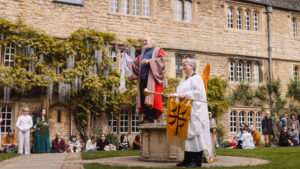 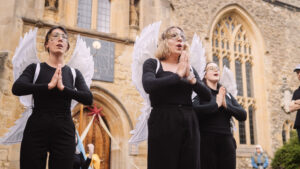 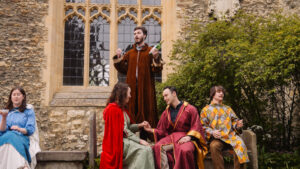
|
|
Lydia Smith (Regular Giving Officer) “I recently got a new puppy, Lemon, who we cannot yet take out for walks as we wait for her to get her final vaccinations. This week, I will do the walking for her, taking my puppy in a bag for a daily walk of 1.317 miles or more and writing a daily summary using 13 or 17 words.” Day One in 13 words: First trip on the train, visit to Christchurch Meadow and Medieval Mystery Play!
|
| The Choir of St Edmund Hall “Guillaume de Machaut (c.1300–1377) was one of the most important composers and poets of the Middle Ages. His virelai ‘Douce dame jolie’ is a delicate and heartfelt song in which a lover pleads for mercy from an unattainable lady. It is one of the most celebrated examples of the ars nova style, combining lyrical poetry with elegant, flowing melody. This performance of Douce dame jolie by the choir of St Edmund Hall marks a small tribute to the music of Machaut’s time. The earliest surviving record of St Edmund Hall dates to 1317—just around the time Machaut may have been born. Though Douce dame jolie was likely composed some decades later, it evokes the courtly world of the early 14th century, a world not so far removed from the one in which our Hall began.”
Performed by Director of Music, Carlos Rodriguez Otero, and Choir members Tiffany You (2023, Philosophy, Politics and Economics), Harriet Humfress (2023, Fine Art), Henrike Lähnemann (Professor of Medieval German Literature and Linguistics), Riya Bhattacharjee (2025, Visiting Student in Biomedical Sciences), Catherine Gower (2021, Earth Sciences), Oliver Riordan (Professor of Discrete Mathematics) & Alyssa Chan (2021, Engineering Science). Text and translation Old French: English translation: |
| Jeremy Nason (1974, Natural Sciences) is planning a challenge for the 2nd May.“When I was married my blessing was at Teddy Hall and my reception at the Weston Manor hotel in Weston-on-the-Green so my challenge is to walk from the hotel to the college which based on various mapping apps is 13.17km.” |
| David Picksley (1953, Modern Languages – French and Russian) made a donation to the Aularian Fund. Make Your Gift Today. |
| Phil Budden (1974, Engineering Science) made a donation to the Aularian Fund. Make Your Gift Today. |
| Melvyn Matthews (1960, French) made a donation to the Aularian Fund. Make Your Gift Today. |
| Ian Hewitt (1966, Jurisprudence) made a donation to the Aularian Fund. Make Your Gift Today. |
| David Phillips (1968, Music) made a donation to the Aularian Fund. Make Your Gift Today. |
| Christopher Armitage (1997, Modern Languages) made a donation to the Aularian Fund. Make Your Gift Today. |
|
Basil Lewis (1952, Geography) has written a poem with memories of the Hall and its impact using exactly 1317 letters and figures. “Bedridden now 24/7 Oxford itself was nothing too new Kelly was Principal a canon of note One of my hobbies I now ought to tell A gift that I made to the hall long ago As I lie now awake, that ends my thoughts |
|
David Picksley (1953, Modern Languages – French and Russian) “Between 25 Apr and 2 May I undertake to walk 8.23 miles (13.17km). I hope that we get suitable weather then, but a drop of rain won’t stop me anyway.”
|
|
James Harpham (1959, History) “A carefully swung boogie piano piece based on the notational sequence: 1317 !!”
|
| Tim Miles (1981, Modern Languages) has started a regular gift of £13.17 per month to the Aularian Fund. Make Your Gift Today. |
| Jim Boff (1972, Chemistry) “Inspired by the number of people one might reasonably meet (if not remember) while an undergraduate at the Hall – the following doggerel resulted ——- Uncommon meeters13 17 “characters” You’ll meet them at the Hall 13 17 “characters” Together live life full 13 17 “characters” Learning and friendship gain 13 17 “characters”” Time passes friends remain” |
| Anonymous made a donation of £1,317 towards Student Bursaries and Financial Assistance. Make Your Gift Today. |
| John Trotman (1972, English) “My 1317 Challenge is going to be walking 1,317 k in the year from NOW – and writing a poem of 1,317 words about the inevitable struggles and less inevitable glory.” |
|
David Picksley (1953, Modern Languages – French and Russian) “I have been preparing a talk to be given to a local history society at the end of June. It is on the subject of the two Edmunds who are painted on the wall of our local All Saints Church in Sanderstead. They are the Martyr King and the Archbishop who was appointed while the church was being built from about 1230, namely Edmund of Abingdon. I have managed to tell the stories in 1317 words.”: 1317 Challenge Edmund, (Eadmund) (841-869) was King of East Anglia. He was a Saxon, who was brought up as a Christian and became king before 865. One report says it was in 855, when he was 14. In 869 and 870 the Great Army of the Vikings invaded East Anglia, and Edmund led his troops against them. Much of the detail of this period is lost, destroyed by the invaders, so we are missing registers, charters or correspondence from the time. What we have comes from non-contemporary chronicles by hagiographers. One such was Abbo of Fleury who was a French monk who died in 1004, over 130 years after Edmund. There are coins of the period bearing his name. Because those contemporary documents from his reign were destroyed during this momentous event, few historical facts are known about the crucial battle. The traditional account is that he was defeated and captured. He refused to deny his Christian faith or to rule as the vassal of their leader Ingwar. Consequently, he was whipped, shot with arrows and beheaded. It is claimed that this all took place at Hellesdon in Norfolk, (Haegelsdun); perhaps elsewhere but at least the Anglo-Saxon Chronicle does confirm 869 as the date of his death. He was buried there, and a popular cult emerged after his death, he was seen as a martyr and was canonized by the Church. It seems to have become a norm in the Christian Saxon kingdoms that if a king was killed in a battle with a pagan, he became a martyr and thus a saint. A cult was usually established and would benefit from this. Other examples were Oswald in 642 and Ethelbert in 794. Today canonization is a declaration made by the Pope that the Catholic faithful may venerate a saint. Only since the tenth century is this the case. Later, in 915, Edmund’s body was found to be incorrupt a further indication of sainthood. It was moved to Bedwicksworth, which soon became St.Edmundsbury and later Bury St. Edmunds. A community was set up there to take care of the shrine. In the face of yet another Viking invasion, in 1010, the shrine was moved to London for three years. But the people of Bury wanted it back after that new peril ended. The Danish king Canute (Knut) who ruled England from 1016, and then converted to Christianity, founded the Benedictine Abbey of St.Edmundsbury, in which he placed monks from nearby St.Benet’s Abbey. This was completed in 1032. Edmund’s shrine thus became one of the most famous and wealthy pilgrimage locations in England. An even larger church was built in 1095, into which Edmund’s relics were translated. Almost nothing of this remains other than two entry towers. Two parish churches that were within the precinct of the Abbey did survive, one of them, St James became St. Edmundsbury Cathedral, much rebuilt in the 12th, 16th, and 20th centuries. In 1539 Edmund’s shrine was defaced during the dissolution of the monasteries, and silver and gold was taken away by Thomas Cromwell for Henry VIII. The abbot and his monks were expelled, and the abbey was dissolved. The body remained at Bury, where it is said still to be, but its actual site at the present day is not known. St. Edmund of Abingdon (1175-1240) was born in Abingdon. Edmund was the son of a wealthy merchant known locally as Reginald Rich. This surname or patronymic was not one adopted by the family; they were known as “Of Abingdon”. Edmund was educated in a grammar school. He will have learned French and Latin, the former because it was the language still spoken by the aristocracy and court since 1066. Around 1189 at the age of just 14, he and his younger brother Robert moved to Paris. Just then this was a city in transformation. After taking most of the Angevin Empire from King John, Philippe Auguste was making it a political and administrative capital with a permanent royal residence in The Louvre. Notre Dame was still to be completed. On the under-populated left bank near the church of Saint-Julien-le-Pauvre, some masters were already hiring rooms for lecture courses in the arts. Here the arts curriculum then consisted of newly translated books of Greek and Arabic philosophy, logic, and science. After graduating as master, he returned to Oxford and lectured in Arts for six years from 1195 to 1201. Within the city, as in Paris an informal assortment of dwelling houses was coming into being in which the masters were teaching. Towards the end of the period, he is said to have had a dream in which his deceased mother said that he should no longer dally with secular learning, and so in 1202 Edmund returned to Paris to immerse himself in theology for several years, learning and lecturing. But he did return to England, and after living a year with the Austin Friars in Merton, he incepted in theology at Oxford in 1214. He lectured on that subject from.1214 to 1222, During this time, he is known to have been teaching in a house on the corner of what is now Queen’s Lane and the High Street.Through their closeness in these classrooms, masters and their pupils also formed useful social connections with each other which enabled them to meet the need to secure a living with a benefice. Edmund was given one such in a York diocese which helped to support him financially while living and teaching in Oxford. Through another academic connection, in 1222 he became treasurer at Salisbury Cathedral. This was not a financial appointment. As treasurer he was responsible for the precious objects—the vessels, vestments and reliquaries. He had also to provide at his own expense the oil and wax for lights for altars and shrines, the bread, wine and incense, and pay staff to do all the work involved. This was not so easy for him; besides having always been an aesthete, following closely the demands his religion, he also had acquired the reputation for extreme generosity towards the poor. To meet these expenses the chapter allocated the prebend of Calme in Wiltshire to the treasurership. In 1233 he was appointed Archbishop of Canterbury by Pope Gregory IX after three other elections to this position had been quashed by the pope. This had been on the political grounds that the other candidates had held a secular office for the king, and canon law allowed the secular power no role in the process Although he found administration and politics distasteful, he became an effective reforming bishop. He quite soon clashed with the young King Henry III, defending church rights and criticising the king’s continental policy. The barons supported Edmund. Civil war threatened. But he forced Henry (by threat of excommunication) to expel Henry’s French wife’s relatives and allies and then made the King promise to observe English law and customs. There were a few other clashes with Henry, who in 1236 asked the pope to send a legate, and Cardinal Otho was sent in reply to this request. Henry III upheld the monks of Canterbury in opposing Edmund’s visitations and authority there. In 1240 he was called to Rome. He stopped for a while at the Cistercian Abbey of Pontigny, where the locals admired him his aestheticism and benefitted from his generosity. But he became unwell and left. As he proceeded further, probably to return home, he died at Soisy on 16 November 1240 and was returned to Pontigny where he was buried and has his shrine. Histories claim that during the three-day journey back, crowds of his admirers surrounded the bier, and miracles occurred. An early demand for his canonization, was granted in 1247 by Pope Innocent IV. His legacy is St. Edmund Hall, Oxford. The earliest documentary mention of it by name occurs in a rental of Oseney Abbey for the year 1317-18. |
| James Mabbett (1967, English Language and Literature) made a donation to the Aularian Fund. Make Your Gift Today. |
| Michael Hilt (1955, Mathematics) made a donation to the Aularian Fund. Make Your Gift Today. |
| John French (1956, Modern Languages) made a donation to the Aularian Fund. Make Your Gift Today. |
| Tino Wendisch (2004, Mathematics) made a donation to the Aularian Fund. Make Your Gift Today. |
| Brian Walker (1966, History) made a donation to the Aularian Fund. Make Your Gift Today. |
| Colin Bullett (1968, Chemistry) made a donation to the Aularian Fund. Make Your Gift Today. |
| Chris Pote (1968, Chemistry) made a donation to the Aularian Fund. Make Your Gift Today. |
| Ben Tucker (2007, Engineering Science) made a donation to the Aularian Fund. Make Your Gift Today. |
| Amrik Thomas (2006, Engineering Science) made a donation to the Aularian Fund. Make Your Gift Today. |
| Anonymous made a donation of £100 towards the Aularian Fund. Make Your Gift Today. |

